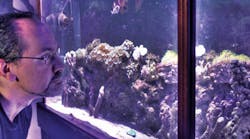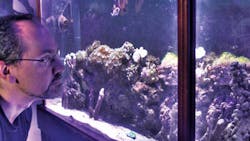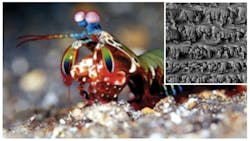"I think Nature is a giant, and we can learn from it” says Professor Pablo Zavattieri in regards to the famous Sir Isaac Newton quote, “standing on the shoulders of giants.” Dr. Zavattieri and his research group at Purdue University have been working to mimic nature to develop new smart materials.
Dr. Zavattieri explains smart materials, also called active materials, respond to an applied external stimulus with a measurable change in some physical property. Examples of external stimulus can be changes in temperature, applied electricity, magnetic fields, humidity, pH, and more. Smart materials respond to those stimuli with changes in their internal structures and intrinsic properties such as stiffness, strength, energy absorption capacity, or optical properties like transparency or opacity.
|
Most smart materials have reversible properties, reverting back to its original state after the stimulus is removed or changed. The cycle can then be repeated. Smart materials are also tailorable and tunable, which means they can be designed for specific, controlled property changes.
Why Look to Nature
“Mother Earth has already done the research and beta testing, and merely needs to be mimicked. She is constantly healing, learning, and adapting,” says Dr. Zavattieri. He references a popular example — the invention of Velcro. About 70 years ago, George de Mestral (a Swiss engineer) visited the Alps with his dog, and they returned with burrs (from burdock) hooked onto his clothes and the dog’s fur. Examining the burrs, he saw them entangled in the loops of the clothes which led to the invention of the hook-and-loop system.
Another example is the Eastgate Centre in Zimbabwe, one of the largest office and shopping centers without an electrical air-conditioning/heating system. Designed by architect Mick Pearce, the building is 31,600 m2 in size and sees outdoor temperature ranges from 0 to 35°C (32 to 100°F). Pearce drew upon self-cooling termite mounds for his inspiration of the building design. The building does not include many windows because windows contribute to a gain or loss of heat. And it further mimics termite towers because it incorporates massive ventilation chimneys which draw cool air in near the ground and expel warm air out of the top of the building. By altering the ventilation of the chimneys, Eastgate Center draws in cool air at night and expels warm air during the day.
Dr. Zavattieri says architects are known for borrowing ideas from nature as they think about sustainable solutions for heating and cooling. He says architects are imagining special skins for buildings that can breathe, control light, and exchange energy with the environment on demand.
The science behind smart materials
Engineers and scientists have been working to understand the art of biomimicry for decades. Research includes solar cells inspired by plant leaves, high-strength fibers inspired by spider silk, multifrequency radars inspired by bats, and camouflage skins inspired by squids.
Zavattieri’s research area at Purdue is largely focused upon nature, particularly to those animals and plants with novel structural designs. He is developing a multidisciplinary program to study these structures and is currently collaborating with Professor David Kisailus from the University of California, Riverside. Research in the Kisailus Lab focuses on the ultrastructural investigation of biological minerals and their formation mechanisms in order to design biomimetic composite structures. The Kisailus lab maintains both temperate and tropical invertebrate species for study.
One promising specimen they are researching is the Chiton — and specifically its teeth. Chitons are small mollusks with teeth that are said to be one of the hardest, antiabrasive biological materials on the planet. Zavattieri says if the microstructure of the teeth can be recreated, society can build wear-resistant buildings, cars, and implants. A new hip may last forever, rather than wearing out after a few years.
Other specimens under research are abalones and mantis shrimps. Abalones are mollusks with a high-toughness layer that is referred to as mother of pearl. Mantis shrimps have developed a composite that is impact resistant, a great property for the automotive and defense industries.
Smart materials shave weight in automobilesIn order to meet the future 54.5-mpg standard, automobile designers are looking at smart materials to replace heavy components. One method of weight reduction that was discussed at the 2013 WardsAuto Interiors Conference in Dearborn, Mich., is using materials that combine textiles with components. Smart textiles that can self-heat and cool eliminate heavy thermoconductive layers currently incorporated in vehicle systems. Smart textiles could also eliminate larger sensors that currently detect whether a passenger is in the vehicle and if the passenger air bag needs to be engaged. Less “smart” materials and more “smart” design, Bayer MaterialScience, Pittsburgh, developed a center-stack concept for the center console. The design replaces bulky circuitry with circuitry printed directly onto the surface of the device it controls. Another weight-saving solution is being applied to the increasing number of built-in screens. Bayer developed a polycarbonate film that replaces the current screens used in navigation, TV, and other displays. The new film is lighter, thinner, and is said to produce less glare. These advancements may seem negligible compared to the weight of an alternator, but Rose Ryntz of International Automotive Components says that a 10% reduction in weight on a vehicle results in a 6 to 7% increase in fuel efficiency. She says to meet 2025 corporate average fuel economy regulations, a vehicle weighing 3,700 lb (1,678 kg) would need to shave 225 lb (102 kg) off its curb weight. |
To understand these microstructures, Zavattieri’s group combines computational modeling, nano and micromechanics, and 3D printing to test hypotheses. They conduct rigorous parametric analyses to determine optimal geometry, size, and scale of the microstructural building blocks that improve key mechanical properties.
Zavattieri’s research group is also studying the use of natural materials to improve existing engineering materials. Current efforts include the development of high-strength cellulose nanocrystal-based cementitious materials. In collaboration with other groups at Purdue, Zavattieri investigates the structure-function relationship through an integrated approach that includes processing, structural and chemical characterization, state-of-the-art microscopy, and multiscale modeling to unravel the physical mechanisms that underpin the nanomechanics of the materials, and relate this to the macroscopic properties. Prof. Zavattieri’s research has the potential for significant advances in the emerging field of high-performance multifunctional materials and, therefore, foster the development of intelligent infrastructure materials for transportation, civil, defense, communication and energy applications, among many others.
The state of smart materials
Looking back five to 10 years ago when Dr. Zavattieri started working with shape-memory alloys in the automotive industry, he recalls seeing smart materials exist mainly in biomedical applications, a little in aerospace, and subtly being considered for other industries like automotive. Most of the mature commercial applications were in the biomedical industry. A common example of a biomedical application was nickel-titanium stents. In aerospace, research and development was ramping up with advances in smart composites for actuators.
Since then, Dr. Zavattieri has seen an increase of research and use. Specifically, the automotive industry is using smart materials to make devices and parts designed for safety, comfort and, of course, to satisfy fuel economy standards. In civil-engineering applications, shape-memory alloys were lately proposed for passive and/or active control for vibrations and earthquakes.
Dr. Zavattieri predicts smart materials will continue to play an important role in the future, especially in the development of smart devices and structures in the biomedical field. However, he sees most of the new applications being applied on a smaller scale, such as microfluidic drug delivery.
Types of Smart Materials
|
Zavattieri points to three aspects of how smart materials will impact the future. First is the discovery of new materials. “Naturally the discovery phase is always interesting as unseen technologies are unveiled. Excitement builds around how a discovery may be utilized and its impact on humanity. The ability to revolutionize and alter the world truly exists at this state,” he says.
The second aspect lies with new combinations of existing smart materials. “Sometimes combinations are necessary to truly maximize the potential of a smart material. One research area involves combining naturally inspired designs with self-building/healing materials. This draws from plants as inspiration, as their designs have been refined by nature over millennia.”
The final aspect relates to the future impact of current materials. “An example is the famous story of Tempur-Pedic mattresses. The foam used in the mattresses was originally developed by NASA during research for a new seat-cushion material,” explains Zavattieri. “While a material’s use may seem clear during development, innovation regularly occurs and a material is ‘reinvented.’ Methods of manufacturing steel emerged in the 17th century and steel is very much still relevant today. Steel itself is ‘reinvented’ through new combinations with other metals and new refining techniques. The ground-breaking research of today is laying the foundation for hundreds of years of additional research in smart materials. The impact will be great and not only benefit the scientific community, but all of humanity.”
This file type includes high resolution graphics and schematics when applicable.





